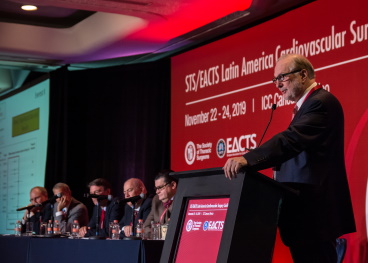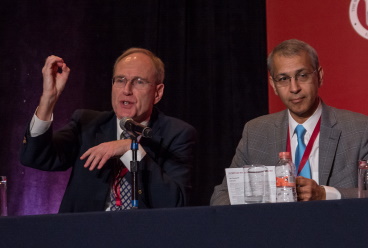STS News, Winter 2020 — The third annual STS/EACTS Latin America Cardiovascular Surgery Conference attracted its largest audience yet—more than 300 cardiac surgeons, scholarship recipients, and industry representatives from 33 countries—to Cancun, Mexico, in late November.
The international faculty explored new developments and best practices in treating cardiac and congenital heart diseases and encouraged audience members to challenge the science and use the best treatment options possible for their patients.

A session featuring rapid-fire presentation of recent trial data proved very popular.
One of the most engaging sessions of the 2.5-day conference was a rapid-fire presentation of recent trial data that had the potential to change clinical practice. Program Director Joseph E. Bavaria, MD, moderated the session that explored more than a half-dozen studies, including the Tendyne Early Feasibility trial.
When Dr. Bavaria asked if Tendyne would change the gold standard from mitral valve repair to mitral valve replacement, panelist Steven Bolling, MD, replied: “Our fear was that as soon as we get a transcatheter mitral valve replacement that works well, we’ll get rid of the concept of mitral repair. If you remember 5 years ago, some believed that these transcatheter mitral replacement devices were going to suddenly take off. But they didn’t. However, I do believe that there will be innovation in transcatheter mitral valve repair. There will be a transcatheter recreation of the surgical tools we have for mitral repair, and mitral repair will remain the gold standard.”
"I do believe that there will be innovation in transcatheter mitral valve repair. There will be a transcatheter recreation of the surgical tools we have for mitral repair, and mitral repair will remain the gold standard."
Joseph F. Sabik III, MD, provided context for the ISCHEMIA trial, which concluded that watchful waiting combined with medical management was better than percutaneous coronary intervention or coronary artery bypass grafting for patients with stable angina.
“Despite the hundreds of millions of dollars that were spent on this study, it means very little for cardiac surgeons. The devil is in the details, and this trial included very few patients who were even eligible for surgery,” Dr. Sabik explained.
Panelists and audience members also discussed the MOMENTUM 3, PARTNER 3, RECOVERY, EVEREST II, and Evolut Low-Risk TAVR trials.

(From left) Panelists Steven Bolling, MD, and Vinod H. Thourani, MD, shared their perspectives on how clinical practice may change going forward.
The final day of the conference featured hands-on activities, where the experts worked very closely with the attendees. Many of the participants were scholarship recipients. The Society’s charitable arm, The Thoracic Surgery Foundation, provided travel scholarships to 65 individuals who wouldn’t otherwise have been able to attend.
Dr. Bavaria, who was the impetus behind the Latin America conference along with Juan P. Umana, MD, said he was thrilled that the meeting continues to grow and provide knowledge to surgeons throughout Latin America. The first two conferences were held in Cartagena, Colombia. The fourth annual conference will be held in November 2020 in Santiago, Chile.
Photos from the conference are available in the Society’s flickr album at sts.org/LatAmPhotos.
Videos of two keynote addresses are available on the STS Facebook page @societyofthoracicsurgeons.